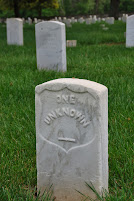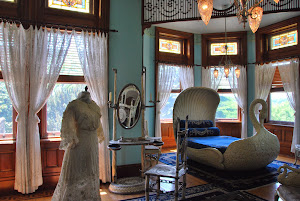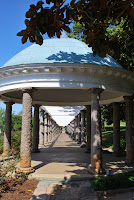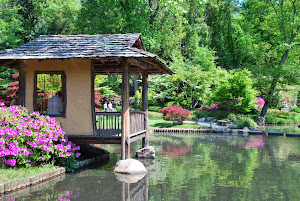 |
| McClean House |
Appomattox Court House (which is a village, not just a building) was our destination of choice on Monday. Located about 2 hours southwest of Richmond, McLean House in the town is the location of Lee's surrender to Grant on April 9, 1865. While the house itself had been dismantled in 1893 with the hope of being reconstructed in Washington, D.C., that never happened and the remains of the building disappeared. However, with photos and plans the house was rebuilt on its original foundation in the 1940s. Several of the other buildings in the area are original to the town.
 |
| Meeks Stable |
 |
| Clover Hill Tavern |
They have recreated the area to appear mostly as it would have looked in April of 1865, and it really gives you a sense of what life would have been like in the time period of the Civil War.
From Appomattox we drove an hour and a half back east to Petersburg, Virginia. Located south of Richmond, we wanted to see the Blandford Cemetery where my Bolling ancestors (I believe them to be mine) are buried. I have to admit that it was quite strange to see Confederate flags on the graves.
 |
| Bolling Mausoleum |
 |
| A few other Bollings outside the masoleum |
 |
| Old Blandford Church, erected 1735 |
The oldest stone, dated 1702, is that of Richard Yarbrough. Veterans of every war are buried there, including Colonel Robert Bolling. But most significant perhaps are the 30,000 confederate soldiers who died in the Siege of Petersburg in 1864-1865. At 189 acres, Blandford is the second largest cemetery in Virginia, behind Arlington National Cemetery. Unfortunately the church was closed, as we would have loved to see the 16 Tiffany stained glass windows inside.
 |
| Centre Hill |
Also located in Petersburg is Centre Hill, a mansion built by Robert Bolling IV in 1827. He was a Revolutionary War veteran. Now a museum, which was closed at the time we arrived, it remained a residence until 1936. While a home, it was visited by two Presidents - Lincoln and Taft. It served as Union headquarters during the Siege of Petersburg, fought from June 9, 1864, to March 25, 1865. President Lincoln met at the house on April 7, 1865, just seven days before he was assassinated. Robert Buckner Bolling, the current owner, was not there at the time, as he was at his country estate in northern Virginia.
Tuesday we visited Montpelier, the home of James and Dolley Madison. Located in Orange County, this drive took us 75 miles northwest of Richmond. Following a short film discussing the accomplishments of Madison as the architect of the Constitution, we had a fantastic tour guide walking us through the mansion. We then strolled through the gardens and saw the family cemetery.
 |
| Montpelier |
 |
| garden gate |
 |
| Madison's stone |
From Montpelier we returned to Richmond, where we checked into the hotel where I spent the next four nights while attending the National Genealogical Society conference. Before Jim took off to Washington, DC for his motorcycle trip, we walked down to see the capitol building and governor's mansion.
 |
| Virginia capitol building |
 |
| governor's mansion |
|
|
|
|
|
|
|
|
|
Jim met back up with me on Saturday, and before we went to the airport we visited Hollywood Cemetery. Set on 135 acres overlooking the James River, this cemetery is the final resting place of 18,000 Civil War soldiers as well as President James Monroe, President John Tyler, Confederate President Jefferson Davis and 22 Confederate generals. The first burial in the cemetery was an infant in 1849.
 |
| 1869 monument to Confederate soldiers |
 |
| dog watches over grave of a child |
 |
| John Tyler |
 |
| James Monroe |
This was a great trip, filled with history, research and new genealogy tips and tricks. A win-win-win.








